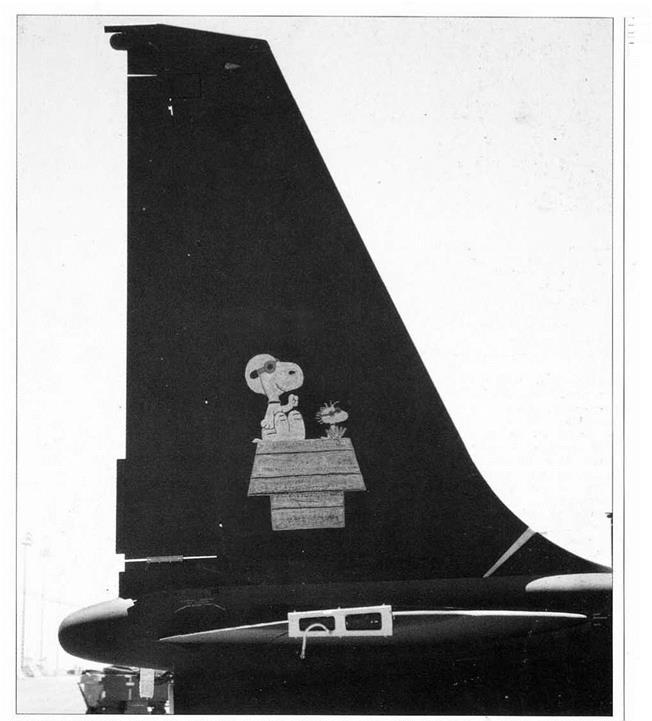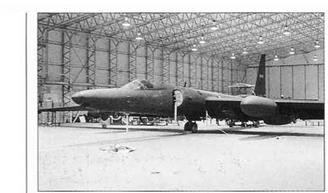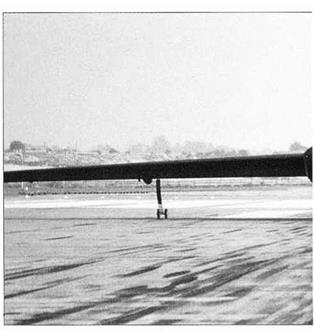Mayday ’
One of the most ambitious sorties planned for the U-2 was a nine hour flight covering 3,800 miles (2,900 of which would be over denied territory). Launched from Peshawar, Pakistan, the flight would recover into Bodo, Norway. The mission’s objective was to locate a new missile base near Plcstsk that the photo interpreters at Auto Mat had been searching for in vain since 1958.
In addition, the route offered an opportunity of gaining additional material from Tvuratam and the military industrial complex around Sverdlovrk.
Above The U-2R still retains the early high altitude air sampling capability; here the unit is being bolted into 69-10338’s Q-bay.
(Paul Crickmore)
Right Nose-art, or in this case, tail-art, has been a feature of US combat aircraft since WWII. This particular example, applied in chalk, adorned the tail of aTR-l B. (Paul Crickmore)
The plan was reluctantly approved by President Eisenhower, who insisted that it should be flown before 25 April. However, due to bad weather across much of the intended route, Eisenhower agreed to extend the deadline to 1 May. On Wednesday 27 April, improving met conditions prompted a detachment from Det В consisting of two pilots and support personnel to deploy via C-130 from Incirlik, to Peshawar. Scheduled attempts to launch on 28, 29 and 30 April were made. However,
 01091
01091
all were aborted well before take-off, due to adverse weather in the collection areas. Finally, at 06:26 local time, on May 1 1960, Francis Gary Powers got airborne in Article 360 and headed for the border. To help draw attention away from the deep penetration mission, a diversionary, peripheral flight left from Incirlik. After three hours and 27 minutes of flight, Powers was stunned to feel and hear what seemed to be a dull explosion, below and behind his aircraft. Almost immediatelv
afterwards the sky turned bright orange and seconds later 360’s right wing dropped. Turning the control yoke left, Powers managed to correct the roll, but then the nose pitched downward – due to damage sustained by the horizontal tail. As the U-2 pitched violently forward, both wings were ripped from the fuselage. Powers face plate frosted over, his partial pressure suite inflated and «hat was left of the aircraft entered an inverted flat spin. Centrifugal forces pinned the pilot to the instrument

![]()
 Above The 17th Reconnaissance Wing and its flying component, the 95th Reconnaissance Squadron, were activated at RAF Alconbury on I October 1982 and became operational five months later. (Paul Crickmore)
Above The 17th Reconnaissance Wing and its flying component, the 95th Reconnaissance Squadron, were activated at RAF Alconbury on I October 1982 and became operational five months later. (Paul Crickmore)
Right Steve Nichols lines-up ‘KONA 17’ an ASARS configured aircraft, prior to departure from Alconbury. (Paul Crickmore)
panel which prevented the use of the ejector seat. Glancing at the unwinding altimeter. Powers noted he was descending through 34,000 ft. Reaching up he pushed the canopy open, unlatched his seat harness and was thrown forward. Now only half out of the cockpit, he realised he’d failed to disconnect his oxygen hose. He then attempted to re-enter the cockpit. When this failed, he began pulling on the hose in an effort to break it. Finally his efforts were rewarded and he was clear; almost immediately his chute was successfully deployed by a barometric sensor – set to activate at 15,000ft. Powers was captured after landing in a field and four days later the political impact of the shoot down reverberated across the front pages of newspapers all around the world.
Operation Overflight, the United States’ most clandestine reconnaissance operation, had literally been blown apart at the seams. An immediate cessation of U-2 overflights followed, backed up later by the retraction of all U-2 operations around the world.
On 10 February 1%2 Frank Powers and the notorious master spy, Rudolf Abel silently passed one another on the Glienicker Bridge in Germany, in a pre-arranged exchange of prisoners. But with 90% of all photographic data on Soviet military developments originating from U – 2 imager)’, the question remained: how, or with what, would it be replaced?










